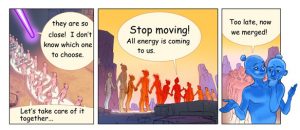UV-induced DNA damage: the very first steps

DNA bases are represented by cartoons characters: (a) a UV photon is absorbed by several bases simultaneously, (b) the movements of the double helix localize the energy of the photon at certain bases, (c) a photochemical reaction takes place.
What happens to the energy of UV radiation from the moment of its absorption by DNA till the occurrence of chemical reactions?
It is well established today that absorption of UV radiation by DNA triggers chemical reactions that may provoke mutations of the genetic code, ultimately leading to skin cancer. Therefore, understanding this complex cascade of events is a challenge related to public health. The DNAexciton project focused on the very first events that take place between absorption of UV radiation and chemical reactions. Its objective was to study how the UV energy is redistributed among the DNA bases (adenine, thymine, guanine, cytosine), altering their electronic structure, and determine configurations that are favorable to the specific reactions. In particular, we examined two classes of reactions, resulting in the fusion of two bases (thymine and/or cytosine) giving rise to new entities: cyclobutanes dimers (CPDs) or 64 photo-products (64PP).
Combining state of art experimental and theoretical techniques in an interactive way. Experimentally, we followed the fate of the absorbed UV energy by spectroscopic methods; thanks to laser techniques we could detect fluorescence emission and/or absorption at times ranging from 10-13 to 10-3 seconds after the absorption of UV photons. We also quantified the dimeric photoproducts produced following UV irradiation by analytical methods: liquid chromatography coupled to mass spectrometry. Finally, we rationalized our observations using various theoretical approaches: quantum chemistry, molecular dynamics and exciton theory. This is the first time that the UV-induced reactivity of DNA is investigated together with energy aspects in the frame of an interactive modeling –experiment study.
Major results. DNAexciton has clearly evidenced the collective behavior of DNA bases versus UV radiation, not only for model systems but also for natural DNA isolated in solution. Such a behavior arises from the proximity of the DNA building blocks within the double helix. It depends strongly on its internal motions which may be affected by external factor, as for example, the presence of salt in the aqueous environment. Due to this cooperativity, an important fraction of the energy deposited by a UV photon may be kept at the level of the bases 1000 times longer, compared to what would have happened in the absence of interaction among them. Moreover, the energy may migrate to specific sites reinforcing their propensity to react. This happens in the case of methylated cytosines, their methylation being a natural process involved in important biological functions.
Scientific production. DNAexciton produced 14 articles in international journals; the majority of them are cosigned by at least two partners. Some of them were published in the highly rated Journal of the American Chemical Society, while others have targeted the community of photobiologists. The scientific results were also presented in 12 international conferences (11 invited lectures).
Facts. DNAexciton was a project of fundamental research. It was coordinated by Dimitra Markovitsi (LFP, CNRS URA 2453, CEA Saclay) and associated Thierry Douki (LCIB, CEA Grenoble). Two foreign teams: Irene Burghardt (Goethe-Universität, Frankfurt am Main) and Roberto Improta (CNR, Napoli) participated also to the project. The project started on March 2011 and lasted 48 months. The ANR funding, received only by the French teams, was 488 k€, for a total cost of 1370 k€.



